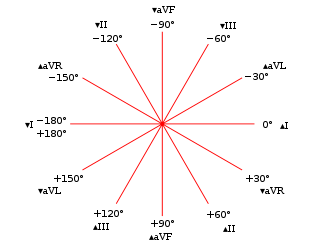Hexaxial reference system

The hexaxial reference system, better known as the Cabrera system, is a convention to present the extremity leads of the 12 lead
electrocardiogram,[1]
that provides an illustrative logical sequence that helps interpretation of the ECG, especially to determine the heart's electrical axis in the frontal plane.
The most practical way of using this is by arranging extremity leads according to the Cabrera system, reversing polarity of lead aVR and presenting ECG complexes in the order (aVL, I, -aVR, II, aVF, III). Then determine the direction the maximal ECG vector is "pointing", i.e. in which lead there are most positive amplitude - this direction is the electrical axis - see diagram.
Example: If lead I has the highest amplitude (higher than aVL or -aVR), the axis is approximately 0°.
Conversely, if lead III has the most negative amplitude it means the vector is pointing away from this lead, i.e. towards -60°.[citation needed]
An alternative use is to locate the most isoelectric (or equiphasic)[ECG.[clarification needed]
For example, if the most isoelectric (or equiphasic) lead is aVL, the perpendicular lead on the hexaxial reference system is lead II. If lead II is positively deflected on the
ECG
, the heart's electrical axis in the frontal plane will be approximately +60°.
- Normal axis: -30° to +90°
- Left axis deviation: -30° to -90°
- Right axis deviation: +90° to +180°
- Extreme axis deviation: -90° to -180°
Additional images


See also
- Electrocardiogram
References
- ISBN 978-1-907830-30-3. Retrieved 29 March 2021.
